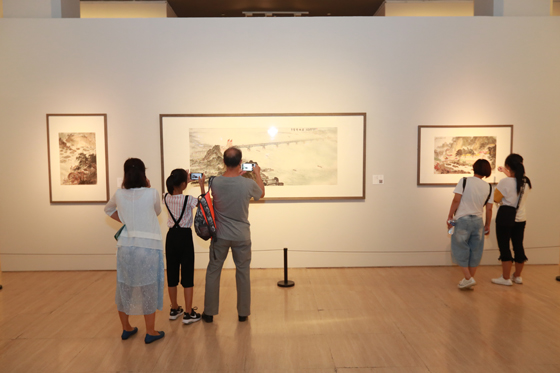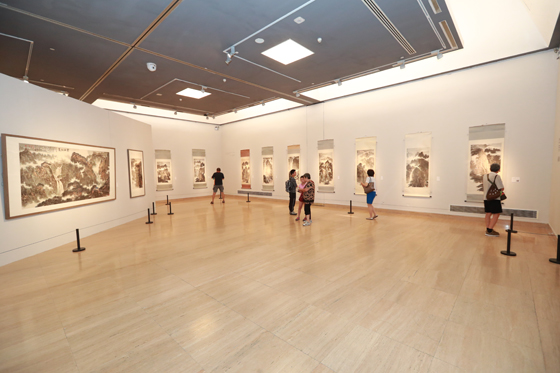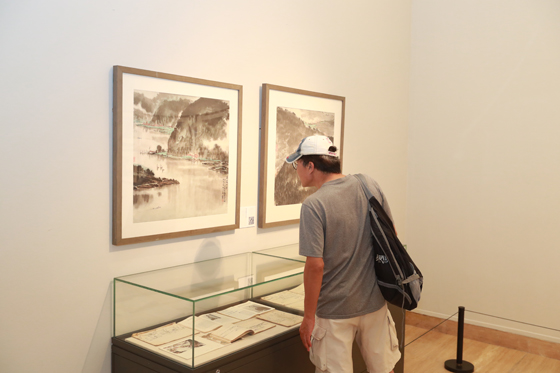“Donation and Collection Series Exhibition of National Art Museum of China: Charm and Magnificence of Chinese Landspace Painting—Art Exhibition of Wu Linsheng’s” Unveiled In NAMOC
Source:: Time:2017年08月24日
“Donation and Collection Series Exhibition of National Art Museum of China: Charm and Magnificence of Chinese Landspace Painting—Art Exhibition of Wu Linsheng’s” unveiled in China on August 13, 2017. On the day, the exhibition opening ceremony and donation ceremony were held in the Lecture Hall on seventh floor, National Art Museum of China (NAMOC).
Mr. Wu Linsheng (1924—2008), born in Zhejiang province, China. Graduated from Department of Fine Arts, National Central University in 1948. In 1949, he served as chief of art, Literature and Art Section, Nanjing Military Control Commission. From 1951 onwards, he began teaching in Department of Fine Arts, Nanjing Normal College and became associate professor while at the same time serving as head of the Teaching and Research Section of Traditional Chinese Painting. He worked as a professional painter of Jiangsu Traditional Chinese Painting Institute, and member of China Artists Association began in 1978. He held personal painting exhibitions in Nanjing and Guangzhou in 1985 and 1988. His works were selected into the National Fine Arts Exhibition and the Modern Chinese Painting Exhibition many times. These works were exhibited in the US, Japan, Canada and Australia among other countries. Kill Bandits in Remote Mountains was selected into the PLA 30 Years Anniversary Art Exhibition. The Mountain Area’s Water Project was awarded the third prize in the First National Youth Art Exhibition. Quite a number of his works were collected by such important collection agencies as China People's Revolution Military Museum, NAMOC, and Museum of the Chinese Revolution among others.
As noted by Mr. Wu Weishan, Director of NAMOC, after the People’s Republic of China was founded, landscape painters commenced, under the new historical background, innovation in thought and painting technique, presenting an unprecedented new visage of the old way of landscape painting in social reality and revolutionary needs. Under the guidance of socialist literature and art policy ,the neo-Nanjing school of painting, as represented by Fu Baoshi and Qian Songyan advanced development of socialist literature and art by a region-featured collective force. They painted life, eulogizing the time with a historical new high in content and technique. Mr. Wu Weishan, as an important member of the neo-Nanjing school of painting, was naturally part of this art evolution.
Mr. Wu Linsheng learned from Mr. Xu Beihong, Fu Baoshi and Huang Junbi among other celebrated painters during his school years. He had been especially so favored by Mr. Fu Baoshi " that he was said to be the “only person who knows Mr. Fu Baoshi’s painting” (quotes from Ya Ming) and was his teaching assistant during his time in Nanjing Normal College. Mr. Fu had a huge influence on Mr. Wu Linsheng’ mind and creation, which later embarked his art career by the Mr. Fu’s way of landscape painting . In Mr. Fu’s teaching of landscape painting, he emphasized combination of painting history, painting theory and creation. Mr. Wu recorded and studied Mr. Fu’s lecture notes and Notes on Literature and Art. His awareness of art from theoretical perspective was greatly improved. Mr. Wu followed Mr. Fu in painting from life for his art creation. He perfected self –expression by efforts on learning from nature, taking life as model, comprehending ancient technique from painting from life, exploring new technique, and creating one of himself.
From 1950s to 1970s, Mr. Wu’s artistic creation and historical background were closely connected. In the fervent socialist transformation and construction, he turned his viewing angle to eulogize and present the time of life then. Like many of the painters then, Mr. Wu began trying to combine worker and peasant image with landscape painting. During the 1950s and 60s, he created Mountain Area Busy with Harvest, Tending Ducks, Red in the Country with Peasants and Expert in the Country with Peasants. Such works had strong imprint of the time. The depicting of worker and peasant image expressed the new atmosphere and new look emerged from the new period. Landscape painting had advantage in technique when it came to express construction result and revolutionary famous historical sites. Foziling Reservoir, Mr. Wu created in 1953 expressed the construction scene of large-scale hydraulic project of the New China. Overcome Severe Cold was a fervent scene of construction site on the Beijing-Hangzhou Grand Canal Liushan Shiplock. The construction of the Nanjing Yangtze Bridge was a theme often expressed by painters in Nanjing. In the 1970s, Mr. Wu’s A Deep Chasm Turned into Thoroughfare experienced quite a few drafts before it became what we know it today. The painting recorded the great achievement of the socialist construction. When it comes to expression of the theme of famous revolutionary historical site, Mr. Wu, created, in the form of landscape painting, Jinggang Mountain, Today’s Luding and Zunyi Eulogy among others. These works expressed his reverence towards holy revolutionary historical sites. With regards to the creation of chairman poesy drawing, Mr. Wu was obviously influenced by Mr. Fu Baoshi. His Climbing Mount Lu and Liupan Mountain blended revolutionary poesy and landscape art language and enriched the creation content of chairman poetic landscape painting.
After the Cultural Revolution, Mr. Wu Linsheng was transferred from Nanjing Normal College to Jiangsu Traditional Chinese Painting Institute where he could be dedicated to landscape painting. He, in the prime of his life, embraced the golden period of his career as a painter. Landscape painting was no longer made to serve politics but was pursued with modern exploration of its noumenon language. He continued his efforts in inheriting and carrying forward Mr. Fu’s drawing ideology, seeking landscape painting’s innovation in painting from life. Mr. Wu’s tidying up of Fu Baoshi on Notes on Literature and Art allowed him to conclude the sketching of Chinese landscape painting into four words: travel, disillusion, record and write, to which he gave detailed interpretation. Mr. Wu experienced in-depth and practiced Mr. Fu’s way of painting. He traveled around the country to paint from life, searching for all marvelous mountains in nature and making them drafts of painting. With paintbrush to speak and write biography for waters and mountains, he created a great number of landscape paintings. For example, Water and Mountain in Miaojiazhai (hail of western Hunan scene), Yandang Mountains Dwellings presenting the beauty of Yandang Mountains, the Majestic Changbai Mountain, demonstrating the beauty of northeast scenery, The Majestic Alps, expressing the beauty of foreign land, The Spring of Lake Taihu (beauty of south of Yangtzi River). Mount Huang is an important theme of creation of Mr. Wu’s landscape painting. He ascended Mount Huang three times, taking it as model to have created an array of Mount Huang subject matter related works. In his eyes, nature should be learned and natural scenery can’t be turned into art works unless there’s innermost inspiration integrated. Many paintings under Mr. Wu’s paintbrush not necessarily refer to any particular famed mountain or river. He turns his inspiration on nature into mountain and water image. Just as what Mr. Guo Xi said, “Successful art creation depends on detailed observation of nature.” He expresses his feelings direct and straight with his paintbrush and makes mountain and water the reflection of his self-spirit.
To paint from life in nature and to experience in life, is important path to inherit , carry forward and revolutionize ancient way of landscape painting for the 20th century landscape painters. From Zhao Wangyun and Shi Lu in northwest to Li Xiongcai and Guan Shanyue in south of the Five Ridges, to Fu Baoshi and Qian Songyan in the Nanjing art circle, none of them didn’t open up their mind and boost their courage during their sketching of life and life experience, exploit and create new technique of landscape painting to form the new pattern of modern landscape painting. Mr. Wu follows Mr. Fu’s footstep, seeking unification of landscape painting technique, social reality ad individual spirit expression. In terms of landscape painting’s language and texture, Mr. Wu directly inherited Mr. Fu’s method of scattered peaks enabled at one stretch by Fu’s drawing technique. Bark paper can also be chosen to be applied repeated colors. What is different from the equally heroic and generous Bao Shicun, is incorporation of Mr. Wu’s lenience, genial temperament and south of the Yangtzi River connotation. Under his paintbrush, what is presented is clear and rich drawing technique in majestic force. This is where his charm lies with his landscape painting language. His art creation together with contemporary neo-Nanjing school of painters co-constitutes an important chapter in the history of modern landscape painting.
During the Exhibition, his family member donated 29 most representative of his works to NAMOC for permanent collection.
The Exhibition, presented in Hall 3, 5 and 7, ground floor, NAMOC will be expecting visitors till August 21, 2017 (not open to the public on Mondays).




